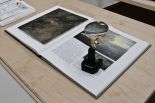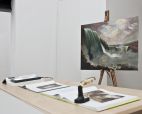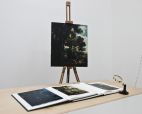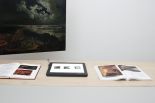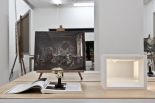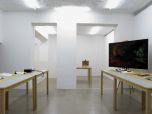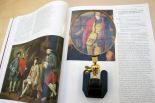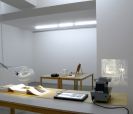| 25.09. – 19.11.2010 | Matts Leiderstam. Grand Tour (co-production steirischer Herbst) |
|
(Johanna Glösl)
Matts Leiderstam
Koproduktion steirischer herbst
Eröffnung / Opening
(scroll down for english version)
Grand Tour Der Ausstellungstitel bezieht sich auf die Bildungs- und Kunstreisen junger Adeliger seit dem späten 17. Jahrhundert. Solche Reisen dienten der Erweiterung des geistigen Horizonts, gleichzeitig bildeten sie eine Voraussetzung dafür, später führende Positionen in Politik und Administration einnehmen zu können. Die Grand Tour war jedoch nicht nur eine Bildungsreise, sondern diente auch dem Amusement der jungen Männer. Auch hierauf spielt Matts Leiderstam (*1956) mit dem Titel seiner aktuellen Ausstellung im Grazer Kunstverein an. Die erotische und geschlechtliche Kodierung von Kunst und Kunstgeschichte ist ein wichtiger Aspekt für die Arbeit des in Stockholm lebenden Künstlers. Grand Tour versammelt eine Reihe von Arbeiten und Fallstudien, die sich meist auf Positionen und Werke der klassischen Malerei des 17., 18. oder 19. Jahrhunderts beziehen. Leiderstam macht diese Werke zu seinem eigenen Material, in dem er sie kopiert oder fotografiert, verändert, in neue Zusammenhänge stellt und dabei aktualisierende Perspektiven für sie herstellt. Seine Methoden sind dem Instrumentarium der Kunstgeschichte und des Museums entliehen: Bilder neu zu hängen, die Restaurationsgeschichte oder Provenienz eines Bildes zu erforschen, Gemälde zu kopieren oder Ausschnitte aus Bildern zu vergrößern und isoliert zu präsentieren sind nur einige der Verfahren, deren er sich regelmäßig bedient. Gemäldegalerien, Kataloge und Bibliotheken liefern das Ausgangsmaterial seiner Arbeit, mittels der er die Wahrnehmung der Betrachterinnen und Betrachter auf die persönlichen, machtpolitischen und sexuellen Kontexte von Kunstwerken lenkt. Leiderstams Arbeit basiert immer auf zeitintensiver Recherche. Mit der für ihn spezifischen Art, Visualität transdisziplinär als Instrument künstlerischer aber auch historischer und sozialer Forschung einzusetzen, kreiert er eine bislang einzigartige Position zwischen kunstproduzierender und -vermittelnder Praxis.
Arbeiten Nach Canaletto Nach Johann Christian Dahl Nach Giovanni Battista Piranesi Mittels verschiedener Quellen und malerischer Eingriffe stellt Leiderstam auf diesem Tisch Zusammenhänge zwischen der Grand Tour und dem Cruising her - letzteres bedeutet im Kontext schwuler Sexualität die mobile Suche nach spontanem Sex - meist mit unbekannten und wechselnden Partnern. After Canaletto zeigt zum Beispiel die von Leiderstam gemalte Kopie einer Kanalszene Canalettos aus dem Ausstellungskatalog Grand Tour - The Lure of Italy in the Eighteenth Century. Leiderstams Kopie bildet nur einen Ausschnitt daraus ab. Dieser lenkt die Aufmerksamkeit auf eine Gruppe von Männern. Im Original erscheinen diese eher marginal. Bei Leiderstam sind sie dagegen deutlich auf der Piazetta zu sehen - seit den 1980er Jahren ein bekannter Treffpunkt Homosexueller - wo sie in Gespräche involviert scheinen oder flanieren. Leiderstam malt das Detail so ab, dass es die Größe einer möglichen Abbildung im Katalog bekommt. Er legt es wie eine Detailansicht in den aufgeschlagenen Katalog, neben die Seite, die das Original Canalettos abbildet. Bei genauerer Betrachtung wird erst klar, dass es sich um ein gemaltes Bild handelt, das hier 'abgelegt' wurde. Leiderstam infiltriert den Katalog - ein Format kunsthistorischer Wissensvermittlung - mit seiner eigenen Fantasie von der Szenerie. So bezieht sich auch die Arbeit After Piranesi auf einen mittlerweile für das Cruising beliebten Platz. Der ebenfalls auf dem Tisch präsentierte, aufgeschlagene Spartacus International Gay Guide dient als internationaler Reiseführer, der Homosexuellen diese Orte und deren Lage nennt. Leiderstam hat einige der darin genannten Parks und Orte in den klassischen Stadt- oder Landschaftsmalereien wiedergefunden, die er auf Tisch 1 thematisiert.
Tisch 2 Nach Hamilton, nach Reynolds Hamilton, eine der wichtigsten Figuren der Kunstszene Roms während des 18. Jahrhunderts, wird als Sammler und als Reisender dargestellt. Auch hier sind es die Details am Rande, die Leiderstam in den Bildern interessieren und die sich auf die Form des Beisammenseins der Rom-Reisenden als Gemeinschaft richtet.
Tisch 3 Nach Gustave Courbet Gustave Courbets berühmtes Gemälde Le rencontre, ou Bonjour Monsieur Courbet (1854) zeigt ein fiktives Treffen des Malers mit dem Sammler Alfred Bruyas, der von seinem Diener begleitet wird. Ort der Begegnung ist ein Weg außerhalb Montpelliers. Leiderstam nahm diese Anekdote und die in der Kunstgeschichte ikonografisch codierte Darstellung der Begegnung von Künstler und Sammler zum Anlass, um eine ganz andere Form männlichen Zusammentreffens zu thematisieren: Heute befinden sich rund um Montpellier, wie beispielsweise auf den beiden Rastplätzen von Saint Aunès beidseitig der Autobahn A9, weithin bekannte Cruising-Sites, auf denen sich homosexuelle Männer zu spontanen intimen Treffen einfinden. Leiderstam fertigte zwei Gemälde mit Ansichten der besagten Autobahnraststätten an. Die Rückseiten der Gemälde fotografierte er auf der jeweils gegenüberliegenden Raststätte, deren Vorderseiten jedoch in seinem Atelier.
Tisch 4 Nach Anonymus (Der Künstler bei den Niagara Fällen) In der Albright-Knox Art Gallery im US- amerikanischen Buffalo entdeckte Leiderstam das Gemälde eines anonymen Künstlers aus der ersten Hälfte des 19. Jahrhunderts, das eine Ansicht der Niagarafälle zeigt. Er kopierte es in Originalgröße und brachte seine Reproduktion im Oktober 2001 an den Ort, der auf dem Gemälde dargestellt ist, um sie vor dem Hintergrund der Niagarafälle an der Grenze zwischen den USA und Kanada zu fotografieren.
Tisch 5 View (Papago Park) In der neunteiligen Fotoserie View (Papago Park) arbeitet Leiderstam mit den sogenannten Claude-Gläsern, die Landschaftsmaler des 18. Jahrhunderts häufig als Malhilfe verwen- deten, um farbliche Tonabstufungen besser erkennen und malerisch umsetzen oder sich eine Landschaft unter verschiedenen Tageseinflüssen vorstellen zu können. Sie wurden aber auch von Touristen verwendet, um mit ihrer Hilfe die Natur intensiver wahrzunehmen. Leiderstam benutzt dieses historische Instrument allerdings nicht, um empfindsame und raffinierte Lichtstimmungen zu erzeugen, sondern hält die einzelnen Filter mit wissenschaftlicher Systematik nacheinander vor das Objektiv seiner Kamera. Das Landschaftsmotiv, das nun in die Farben des jeweiligen Filters getaucht erscheint, ist dabei keineswegs ein unberührtes Arkadien, sondern ein Landstrich, der sich durch die heterogene Nutzung verschiedener Interessensgruppen auszeichnet. Während die Berglandschaft im Hintergrund der Arizona National Guard als Trainingsgelände dient, hat sich der Parkplatz im Vordergrund als Cruising-Site etabliert, der von Homosexuellen für zwanglose Begegnungen frequentiert wird.
Tisch 6 Nach Pierre-Jacques-Antoine Volaire Im Mittelpunkt dieses komplexen und prozessualen Werks steht Pierre-Jacques-Antoine Volaires Gemälde L’éruption du Vésuve aus dem Jahr 1771. Im Art Institute of Chicago, wo es zwischen einer Obeliskendarstellung und einer erotischen Verführungsszene ausgestellt ist, weckte die in dieser Nachbarschaft doppeldeutig zu verstehende Darstellung einer Vulkaneruption Leiderstams Interesse. Seine Nachforschungen ergaben, dass das Werk in den 1940er Jahren im Besitz einer schwedischen Familie in Göteborg war, dem Geburtsort Leiderstams. In Chicago fertigte er eine originalgetreue Kopie des Gemäldes an und brachte diese zurück zu dem dargestellten Schauplatz. Die drei Dias zeigen das Gemälde in der Vulkanlandschaft, in privaten Räumen mit großbürgerlichem Interieur sowie in musealer Umgebung.
Tisch 7 Nach John Constable, nach Claude Lorrain, nach Nicolas Poussin Diese Installation ist eine der ersten Arbeiten Leiderstams, in denen er die Aneignung historischer Kunstwerke - durch das malerische Kopieren und das Modifizieren kleiner Details - als künstlerische Strategie praktiziert und problematisiert. Leiderstam kopierte zunächst John Constables Gemälde Landscape with Goatherd and Goats, after Claude (1823) – das seinerseits eine Kopie von Claude Lorrains Paysage avec un chevrier (1636–1637) ist und stellte seine Fassung auf einer Staffelei direkt neben das Bild des englischen Malers. Der Titel der Installation animiert dazu, die beiden Bilder zu vergleichen und Fragen nach Originalität und Autorschaft, nach Authentizität und Täuschung, nach unbewusstem Einfluss und bewusster Bezugnahme zu stellen. Dem aufmerksamen Betrachter entgeht dabei nicht, dass der Jüngling im Vordergrund, der auf Constables Gemälde selbstversunken und in sich gekehrt wirkt, nun aufmerksam aus dem Bild heraus den Betrachter gezielt anzuschauen scheint.
Tisch 8-9 Nach Hubert Robert, nach Jacob More Leiderstam zeigt eine Kopie, die er nach einer Malerei von Hubert Robert angefertigt hat. Das Original Roberts zeigt dessen Selbstportrait in seinem Atelier in Rom. Robert ist so vertieft in seine Arbeit, dass er nicht bemerkt, dass Zeichnungen von den Wänden fallen oder ein Hund mit seinen Hausschuhen spielt. Er übersieht sogar, dass eine Statue, die in einer Ecke steht, ihm zuwinkt, so als wäre sie lebendig. Matts Leiderstam hat aber ein Detail seiner Kopie gegenüber dem Original verändert: in Leiderstams Version des Bildes dreht der Künstler seinen Kopf in Richtung der Betrachter. Das von Leiderstam zusätzlich angefertige Karton/Papier Modell stellt das Atelier Roberts nach, so, wie es in der Malerei erscheint. Auf die eine Seite des Modells wird ein Dia projiziert, das Leiderstams Kopie des Gemäldes nochmals zeigt, wie es auf einer Staffelei neben dem Original im Museum steht. Das Dia wird genau so projiziert, dass das Licht, das darauf durch das Museumsfenster einfällt, nun in das Fenster des Modells fällt.
Tisch 10 Für die Serie Returned hat Leiderstam mehrere Adaptionen des Gemäldes Le Printemps ou le Paradis terrestre (1660-1664) von Nicolas Poussin angefertigt, wobei er nur die Landschaft kopierte, auf die Figuren von Gott, Adam und Eva aber verzichtete. Seine Bilder hat er in verschiedenen Parks, die als Cruising-Sites (vgl. Text Tisch 1) bekannt sind, auf Staffeleien gestellt, fotografiert und dann zurückgelassen, ohne sich um deren weiteren Verbleib zu kümmern.
(english)
Grand Tour
It is obvious that Matts Leiderstam (*1956) had this dimension very much in mind when he chose the title Grand Tour for his current exhibition at the Grazer Kunstverein. Encoding art and art history with erotic and sexual overtones is an important aspect of Leiderstam’s work as an artist.
Grand Tour assembles a substantial number of individual works and case studies, the majority of which have a bearing on classical paintings of the 17th, 18th and 19th centuries and on ideas expressed in them. Leiderstam turns these works into a kind of material by copying, photographing and adapting them or by putting them into new contexts. In doing so he enables viewers to see them from topical perspectives. His methods are borrowed from the standard arsenal of art history and the museum. New hangings of the pictures, researching the history of their restoration and/or provenance, copying them or enlarging details and presenting these outside their original context – these are only some of the methods that Leiderstam regularly makes use of. Picture galleries, catalogues and libraries are mined by the artist for material to work with, always with a view to focussing the viewer’s attention on the levels of the personal, of power politics and of sexuality in the artworks. His work usually involves a great deal of time-consuming research. In his hands, visuality becomes a transdisciplinary medium both for artistic expression and for historical and social research. This sets him apart from the mainstream and marks his position, halfway between the production of art and art mediation, as unique. Søren Grammel
Works Table 1 After Canaletto, after Johann Christian Dahl, after Giovanni Battista Piranesi Using diverse sources and painterly interventions, Leiderstam construes on this table a connection between the Grand Tour and cruising – in the context of gay sexuality the mobile search for spontaneous and most frequently anonymous sex. After Canaletto for instance is a copy of one of Canaletto’s canal scenes that Leiderstam found in the exhibition catalogue Grand Tour – The Lure of Italy in the Eighteenth Century. His copy selects one detail, a group of men, which is only of peripheral interest in the original. In Leiderstam’s version the men are clearly visible in the piazzetta, which happens to have developed into a well-known meeting point for gay men from the 80s onwards. The men seem to be either involved in conversation or simply out for a stroll. Leiderstam enlarges the detail so that in terms of size it could be a reproduction in the catalogue and places it in the open book on the page facing Canaletto’s original, as if it were meant as a straightforward illustration of some point made about the whole painting. It is only on closer inspection that what looks like merely a detail is in fact discovered to be a painting in its own right, which was ‘deposited’ here. Leiderstam infiltrates the catalogue – a standard device for conveying and defining canonical 'knowledge' – with the fantasies that the scene gives rise to in his imagination. After Piranesi also refers to a site now associated above all with cruising. The also presented and spread Spartacus International Gay Guide lists such sites and their location for the benefit of the gay community. Leiderstam has identified some of them in classical paintings of cities and landscapes and uses them as points of reference on this table.
Table 2 After Hamilton, after Reynolds Here too the artist’s intention is to underline the common ground shared by the Grand Tour and cruising (cp text table 1). Hamilton, one of the most important figures of the art-scene in Rome during the 18th century is encountered both as collector and traveler. Still, it is the peripheral details in the pictures that interest Leiderstam. Table 3 After Gustave Courbet Gustave Courbet’s famous painting Le rencontre, ou Bonjour Monsieur Courbet (1854) depicts a fictitious encounter between the painter and the collector, Alfred Bruyas, who is accompanied by his valet. The meeting takes place on a road outside the town of Montpellier. Leiderstam took this anecdote and its representation, which has been iconically coded in art history, as catalyst for a completely different form of male encounter. Today, in the vicinity of Montpellier - for example, at the Saint Aunès service area on both sides of the A9 expressway - are a number of widely known cruising sites where homosexual men can casually meet for spontaneous intimate encounters. Leiderstam painted two pictures with views of these expressway service areas. He photographed the back sides of the paintings at the service area on the opposite side of the expressway, their front sides were photographed in the artist’s studio.
Table 4 After anonymous (The Artist is at Niagara Falls) Leiderstam discovered a painting by an unknown artist from the first half of the nineteenth century that depicts a view of Niagara Falls. He copied it in its original dimensions and in October 2001 returned with his reproduction to the presumed location depicted in the painting in order to photograph it against the background of the Niagara Falls that straddle the border between the United States and Canada. Table 5 View (Papago Park) In the nine-part photographic work entitled View (Papago Park), Leiderstam works with so-called Claude-glasses, which tourists and landscape painters frequently employed in the eighteenth century to help them determine tonal gradations more easily and realize them in paint (or to imagine a landscape at different times and weather). However, Leiderstam does not use this historic instrument to evoke sensitive, subtle moods by means of light, but instead systematically holds the individual filters one after another in front of the lens of his camera with scientific precision. The landscape motif, seemingly immersed in the colors of each respective filter, is by no means an unspoiled Arcadia, but rather a tract of land characterized by a heterogeneous uses by different interest groups. While the mountainous terrain in the background serves the Arizona National Guard as a site for training exercises, the car park in the foreground has become an established cruising site, frequented by homosexuals for casual encounters.
Table 6 After Pierre-Jacques-Antoine Volaire Pierre-Jacques-Antoine Volaire´s painting L’éruption du Vésuve from 1771 is the centerpiece for this work. The particular context of this intentionally ambiguous representation of a volcanic eruption housed in the Art Institute of Chicago and positioned between the depiction of an obelisk and an erotic seduction scene aroused Leiderstam’s interest. His research revealed that during the 1940s the work belonged to a Swedish family in Göteborg, Leiderstam’s birthplace. In Chicago Leiderstam prepared an exact copy of the painting and returned to the setting depicted in the original. The photo series shows the painting embedded in a volcanic landscape, in private rooms with bourgeois interiors, and in a museum context.
Table 7 After John Constable, after Claude Lorrain, after Nicolas Poussin This installation is one of Leiderstam’s first works, in which he both practices and problematizes the appropriation of historic artwork -i. e. the copying and modification of small details — as a systematic artistic strategy. Leiderstam initially copied John Constable’s painting Landscape with Goatherd and Goats, after Claude (1823) itself a copy of Claude Lorrain’s Paysage avec un Chevrier (1636–1637) and placed his version on an easel next to the painting by the English painter. The title of the installation prompts one to compare both compositions and furthermore to question notions of originality and authorship, authenticity and illusion, and subconscious influence and conscious allusion. The observant viewer cannot fail to miss the youth in the foreground who appears in Constable’s painting to be self-preoccupied and introspective, but now seems to be looking attentively out of the painting directly at the viewer. Table 8-9 After Hubert Robert, after Jacob More Leiderstam also shows a variation on a painting by Hubert Robert (1733-1808). Robert’s original is a self-portrait in the artist’s studio in Rome. The painter is utterly engrossed in his work so that he does not notice what is going on around him. Drawings, having fallen from the wall, are floating to the floor; the dog is making a meal of his master’s slippers; a statue is beckoning to him from a corner. In his version of Robert’s self-portrait, Leiderstam has made the artist turn his head to confront the viewer. He has also created an accurate cardboard and paper replica of Robert’s studio as documented in the painting. One of the replica's side walls is used as a projection screen for a slide that shows Leiderstam’s copy on an easel in a museum side by side with the original. The slide is projected in such a way that the light coming in through the window in the museum now enters through the window of the model.
Table 10 This piece is based on several adaptions of Nicolas Poussin's painting Le Printemps ou le Paradis terrestre (1660 - 1664) which Leiderstam prepared, copying only the landscape but omitting the figures of God, Adam, and Eve. Leiderstam placed his paintings (the adaptions) on easels in different parks, which are known as crusing-sites (cp. text table 1), photographed them and left them there never tracing their further whereabouts.
Kurator / curator
“Matts Leiderstam. Grand Tour” The most striking impression left by Swedish-artist Matts Leiderstam’s exhibition Grand Tour at the Grazer Kunstverein is of the sheer, wide variety of objects. Books are laid out across tables, paintings lie around and on top of books and are mounted on easels, slides lay atop light boxes and are projected by carousels onto walls, and even an architectural model stands in the back, on one of the ten tables populating the galleries. Given the altogether literal nature of the objects, their material diversity clearly evidences exploration (with ideas in various forms) rather than experimentation (with these materials) – the latter being the logical expectation of such formal diversity in an art context. In fact, the artist’s conception of the exhibition’s subject – the Grand Tour, the centuries-long tradition of artists’ and the wealthy’s eye-opening journey through Europe – can well be thought of along the terms of exploration and experimentation, together. Through his artistic practice – of browsing the field of art history, finding surprisingly suggestive objects and traditions and subsequently constructing complicated, pseudo-scientific scenarios through which to shed light on his findings – the artist effectively casts a staid, stable history, conceptions of artistic production, and norms of the presentation of art all in a new light. Where Leiderstam paints a picture, he does so remarkably in the literary sense of the phrase; in this exhibition we find a story told – a story of methodical efforts conjoined with a taste for the subversive. Take Table 3 (After Gustave Courbet), for example. The artist has focused his attention on the well-known Bonjour Monsieur Courbet, but he has collapsed the original subject matter together with one of a highly personal – or, even to say, tangential – nature: over the course of time, somewhere in the area of the original setting, sites have developed where homosexual men casually meet for intimate encounters. Literally by forcing one context onto another – by juxtaposing an art historical text containing a reproduction of the famous painting with the Spartacus Gay Guide 96-97 – Leiderstam generates meaning that is subjective and provocative. One asks oneself, “Was there some question as to Courbet’s sexual orientation, which I have forgotten?” A similar type of self-doubt plagues the viewer when confronted with two canvases depicting two similar but non-identical views of a picnic bench amongst trees. Ambiguously installed on easels between Tables 3 and 7 – notably, facing away from Table 3 (After Gustave Courbet) – the canvases’ point of reference is altogether unclear to the visitor. In fact, viewers have to refer to the exhibition booklet found at the entrance in order to discover the reference that is being made. (Keep this in mind, as the exhibition booklet will become one of many points of reference with which the viewer is confronted.) The two paintings depict views of a highway service area in the vicinity of Montpellier, the region where Bonjour Monsieur Courbet was set. In this way, Leiderstam’s paintings serve to redefine Courbet’s subject in terms of the space’s changed identity in a much later time. Even given the significance that investigated themes such as identity, sexuality, and suppression hold for the artist, questions of bias nevertheless feel a bit out of place here. Objectivity – both as a working method and a means of presentation – clearly holds a valued place at the heart of a scientific process; however, in the context of Leiderstam’s exhibited work, objectivity is merely feigned by the passivity of objects filling the gallery space. Whatever quasi-scientific or, rather, quasi-academic impression the artist’s practice suggests, it is the artfulness of his presentation – the way that the Spartacus guide hides beneath a book here, is elsewhere laid open – which indicates that Leiderstam’s intent is expression. Still, unlike most contemporary painting and sculpture, there is no particular immediacy or personality in the objects that Leiderstam exhibits. (A quietly humming and perhaps lazily clicking slide projector and carousel are in fact the most vibrancy one can find.) Leiderstam’s voice, nevertheless, beckons the viewer – metaphorically, of course – as one nears the magnifying glass perched above a picture (The 8th Duke of Hamilton with Dr John Moore and Ensign John Moore, for example) or a passage in an art history book. Leiderstam speaks through the contrived nature of the setup: “Look what I found, what curious event or nuance, from which we had previously only averted our eyes…” Mostly through specification – by highlighting, cropping, and magnifying – but also through juxtaposition, reproduction, and, generally speaking, by altering the conditions of an artwork’s, object’s, or piece of information’s presentation, Leiderstam exercises control over the conveyance of meaning. The inclusion of an edition of the Spartacus International Gay Guide on each of the first three tables encountered by viewers is a perfect example of this. By decontextualizing, recontextualizing, or fundamentally changing the nature of his subjects, Leiderstam projects his agenda onto them. In this way, contexts make the referenced artworks appear to be active, motivated to reveal deeply hidden secrets. Thirsty for insight as well as intrigue, the viewer, trained to find revelations in or be shocked by contemporary art, then also searches for something hidden in these situations. It is in fact these constructed situations, in all of their complexity – following the artist’s conflation of the practices of connoisseurship, scholarship, and the appreciation of art objects together with intrigue, most evocatively of a sexual nature – which animate conventional histories, contexts, and inanimate objects. In order to address so very many practices within the art world, Leiderstam includes their physical tools. His traditional realm – that of the artist – is exemplified by his painted works which are on view – small-scale sketches as well as large, finished canvases – the latter of which can be found mounted dramatically in wooden easels. The wooden crates scattered throughout the exhibition – often out of the way but not out of view – could be considered as an affirmation that the objects on view are works of art and not merely research materials or technical equipment used in the presentation of art. (Although some of the objects might fit these descriptions, surely not all of them do. Or, at least, this ambiguity is nevertheless a product of the situation in the galleries.) The peripheral presence of the crates could also have been a logistical decision made by the Grazer Kunstverein – a placement based on limitations of space, and, here, the crates’ effect would be to emphasize the exhibition’s presentation in this particular location. Another practice referenced by Leiderstam, connoisseurship, rarely takes place in sight of the viewing public, causing the experience in the gallery to feel like a peek behind the scenes. Connoisseurship can be conceived of as having at least two objectives: to pinpoint the specific identity of artistic efforts as well as to appraise their value. It is the light table, corroboration with scholarly works, and, above all, the magnifying glass, which signify the ultimate attention to subject matter and technical detail – i.e., authorship and technical mastery – that denote this first sense of connoisseurship. With precisely these tools, Leiderstam exercises his motivation: not to authoritatively locate works within their historical milieu, but rather to locate in historical works nuances that resonate with his preference for iconoclasm. In the case of one of Canaletto’s canal scenes, depicted in Grand Tour: The Lure of Italy in the Eighteenth Century, the focus of a magnifying glass held above the reproduction of the painting falls not on the original artist’s treatment in oil paint of contemporary life, but instead highlights apparently homosexual behavior between two men and the reaction of one of their contemporaries. In the detail that Leiderstam paints, which can be found here, on Table 1, the apparent look of aversion on the passerby’s face is pronounced, as is the joyful display of the two other men’s affection. In a way, the potential for Leiderstam to exaggerate the reality evident on the surface of the original canvas is unavoidable, since in producing this detail, he is presenting what he found in the detail, not simply representing the detail. Concerning objects like this detail reproduced in paint by Leiderstam, it becomes clear that in this exhibition – just as in art for some time now – there is a conversation occurring on the subject of reproduction – both the quality of reproductions and also the notion of authorship. In the first place, there is a relatively literal conclusion almost necessarily arrived at when comparing the reproduction of a painting in one book versus its reproduction in another, and that concerns the quality of the reproduction – that is, the quality of the printing and how true, or alike, the printed image is to the original. The fact that it has been scaled down is logically self-evident. However, only in the context of the original work or other reproductions – as is the case here – are qualities such as coloration (or discoloration), contrast, or sharpness evident. In a more abstract sense, it is also possible, in the context that Leiderstam offers, to evaluate the representative capacity of the detail – with its cropped focus and more drastic change in scale. While a detail may offer a closer look at a notable aspect of a work, it also contains the capacity to obscure meaning – much like what is occurring in Grand Tour – by changing a context or doing away with it entirely. Authorship, moreover, comes to the fore when Leiderstam produces painted reproductions. Just as before, with his potential exaggeration of what is depicted, Leiderstam changes the original images in several ways in the course of reproducing them. Whereas he sometimes passively alters images – for example, when he is incapable of painting with the same exact materials, procedures, or capacity as his predecessors – at other times he is active in the alterations. His limitations as a painter are simply impossible to ignore, given his altogether brazen decision to pair his paintings with reproductions of the “masterworks” that inspired them. In one sense, he forces his work into the company of accepted masterworks; in another, he forces the viewer to acknowledge that the quality of his paintings falls short of their precedents. What could be considered a kind of “humility in the age after master narratives” is simultaneously evidence that the value of Leiderstam’s art is found in its conceptual rigor and the finesse of its presentation. By supplementing images with alternate versions, reproductions, and texts, Leiderstam is generating artistic meaning based on the nature of difference extant between art historical sources, source objects, reproductions, altered versions and extraneous material. The focus, however, ultimately lies in the difference between historical artworks and Leiderstam’s most personal interventions. For the reason that the artist does not engage in the age-old master narrative of one-upmanship, instead laying his efforts as a mine field in the vicinity of a source work’s historical standpoint, his being a better or worse painter than his target has no effect on his ability to explode the meaning of his target’s masterpiece. Unattached to tradition, Leiderstam, in his painting, moves freely from large to small scales, from complete reproductions to focused details, from figuration to landscape to abstraction, from finished work to loose sketch. A small canvas lying on Table 1 in fact sticks out as a very liberal interpretation of or reflection on Vesuvius by Johann Christian Dahl. It is so radically different in scale and so loosely painted that it is practically an abstract painting in its own right, merely inspired by the composition of the other painting. It is precisely at this intersection – between reproducing another artist’s work, altering the source in the process of reproduction in order to manipulate its meaning, and freely calling upon vastly different formal identities as a painter – where the questions stand, provoked into being posited: What games is Leiderstam playing with the identity of art and artists, his own included? There is a tradition in art of the “master’s copy,” wherein one recreates a work of particular quality, most often as a student, intending to learn how a work was made or how to make a good work, and other times simply as an homage. Although this procedure is at work here, the motivation is not the same. The works addressed by Leiderstam in Grand Tour are selected for their being masterful, yes, but also for their relevance to the world outside of the straight, white, male, institutional canon. These works either already exhibit some counter-canonical content, perhaps over time they have developed a subversive connotation, or Leiderstam found in them some resonance that was particularly meaningful to him. In most cases, it appears that the last was the case, and that this resonance was between the physical setting for a historical work and the modern reality that gay men have recently used the setting as a cruising site. The objective of Leiderstam’s “extensive research” and his subsequent presentation is not about representing the universe depicted in a specific work, but about scratching at the surface of history and revealing something fundamental to reality. For a prime example of Leiderstam’s active manipulation of a work, take his treatment of Hubert Robert’s The Artist’s Studio. The original painting is described in the following way within another copy of the aforementioned text – Grand Tour: The Lure of Italy in the Eighteenth Century – found, here, on Table 8-9: “The statue of a young man on the left of the picture is extraordinarily lifelike, and its pose, turned towards the artist, almost seems to be trying to attract his attention.” Leiderstam, however, subverts this relationship. In his reproduction, the depicted painter looks directly outwards. By turning the attention of the painter, the subject of the picture, towards the viewer, this sense of attraction is deflected onto the viewer. In fact, the depicted painter, conceived of as a substitute for Leiderstam, himself, suggests Leiderstam’s active, perhaps provocative surveillance of the situation. Viewed another way, in that Leiderstam had the same struggle with the figure’s attention during the course of creation, it is as if Leiderstam were reflecting an experience through the canvas or figure as if with a mirror. In fact, Leiderstam repeatedly turns the gaze of paintings’ subjects towards the viewer; this is the case in the painted reproduction of The Artist’s Studio as well as in the painted detail of Bonjour Monsieur Courbet. Moreover, the artist repeatedly invokes self-portraiture or presents objects that carry a structural emphasis on the experience of the artist – ie. plein air paintings, depictions of an artist’s studio, or even documents or products like those picked up along the Grand Tour. Scattered throughout the exhibition, these representations of subjectivity have the effect of snapping the viewer back from being immersed in the meta-narrative of an investigation into art and history to acknowledging the immediate narrative of a contemporary artist’s – namely Leiderstam’s – personal undertaking. To return for a moment to The Artist’s Studio, although exchanged gazes are perhaps the most charged aspect of the work, it is a bust of a woman, a dog, the light coming in through the window, and the artist at work that are most formally pronounced. Thus – following just this kind of multiplicity of information – does relevance, in a general sense, appear as a live ground on which visitors to the exhibition must tread. As well as needing to constantly evaluate Leiderstam’s relationship to sources for the insight into the artist’s motivation that they evidence, visitors’ are also confronted with a vast pool of sources, wherein the specific point of interest is not always contained or explicit. This is the necessary consequence of an exhibition such as this one, so busy with objects and inanimate contextual information that the result is somewhere between a cacophony of tangents and a dull drone of irrelevancies. Visitors to a contemporary art exhibition are not fully accustomed to reading texts, for one thing. As a result, viewers either struggle with the fact that the artist is not more generous – showing videos, paintings, sculptures, or other, more easily digestible, visual material – or viewers simply do not commit the effort required to register, evaluate, and digest the information present in the form of text. In one sense, it is to Leiderstam’s credit that a sense of intrigue still permeates the space. In another, it is exactly the vitality of subversion that draws the visitor in and around the installation, and it is the contrast to the staid canon of straight art history that positions visitors alongside Leiderstam, sharing of his iconoclastic agenda. Much as the voyagers – in the reality that Leiderstam sees – confronted with novelty, excitement, and sensual pleasure along the path of the “Grand Tour,” visitors can indulge in the provocative subtext of the exhibition. Much as the “Claude Lorraine Glass” on Table 5, which is described as, “pleasing and useful for viewing eclipses, clouds, landscapes, &c.,” but which significantly obscures and alters reality, Leiderstam’s Grand Tour puts novelties on display with an intermittent heavy-handedness that supports the viewer’s feeling of having come to a substantial meaning. To compare the presentation of Table 6 with that of Table 4 will aid in highlighting this fine line relating relevance to irrelevance, and objective truth to subjective significance. As presented on Table 6, Leiderstam addressed Pierre-Jacques-Antoine Volaire’s The Eruption of Vesuvius throughout several stages of activity. Intitially, his interest in the unusual context of its installation at the Art Institute of Chicago led him to discover that, for a time, the painting was owned by a couple living in the city of Leiderstam’s birth, Göteberg, in Sweden. Leiderstam then painted a reproduction of the painting while in the museum and subsequently photographed his reproduction in a museum setting, in a volcanic landscape like the one depicted in the original, and in a domestic setting like the one in Sweden in which the painting hung. Clearly, the resonance of the work’s provenance with his personal background was a primary motivation for the way in which Leiderstam undertook this process. In contrast, Leiderstam found no such rich personal relationship with the painting of Niagara Falls by an anonymous artist that is considered at Table 4. Nevertheless, like with The Eruption of Vesuvius, he reproduced it and photographed it against a backdrop of the depicted landscape. Ultimately, the relative parallelism of the processes presented at these two tables puts the viewer in a dangerous position, left either to assume that the undertakings share the same logic of personalized motivation or that neither was motivated by any such personal relationship. Explicit or not, accurate or not, convincing or not, Leiderstam’s artistic process and mode of presentation – it should be made clear – posses a value which does not derive from the promise of intrigue, of iconoclasm, or of demonstrated nonconformism. Leiderstam’s work, which appears to hold the consolidation and critical treatment of existing subject matter as an ideal, rather states that there is beauty exactly in process, design, and incisive thought. With Grand Tour, Matts Leiderstam attempts a daring feat: to emphasize the anecdotal in art – an activity which carries with it the inherent risk of misrepresenting the art being taken as a subject. For, were this to happen, any insight into the structural nature of art and history would be artifice, an outcome which would be methodologically opposed to Leiderstam’s sober but artful expression. In fact, Leiderstam’s art avoids appearing shallow, since the connections it builds between rarified artworks and provocative themes, such as sexuality, is founded on the artist’s largely personalized and always thoughtful considerations. Moreover, the artistic activity embodied by Grand Tour does not overly trivialize its mostly canonical subject matter. Leiderstam’s is a sincere type of investigation, treating forms and concepts simultaneously, borne only out of earnestness. Mit fremden Augen sehen. Matts Leiderstam „Grand Tour“
Der Empfang ist nicht gerade spektakulär. Der Besucher, der den ersten Raum der aktuellen Ausstellung im Grazer Kunstverein betritt, blickt auf zwei rückwärtige Leinwände, aufgebockt auf Staffeleien. Links davor stehen zwei Holztische mit einigen aufgeschlagenen Büchern, auf denen Lupen und kleine Ölgemälde arrangiert sind; rechts noch ein Tisch, darauf ein Leuchtpult und ein Computer. Es entsteht der Eindruck, man habe sich in ein wissenschaftliches Forschungslabor oder eine Künstlerwerkstatt verirrt. Überall stehen Transportkisten. Die Kisten erzeugen das Gefühl eines Hinter-die-Kulissen-Schauens, und genau mit diesem Element wird hier bewusst gespielt.
„Grand Tour“ nennt der schwedische Konzeptkünstler Matts Leiderstam (*1956) seine seit einigen Jahren durch europäische Kulturinstitutionen tingelnde Installation. 1996 begonnen und erstmals 1997 auf der Biennale von Venedig gezeigt, verändert sich das Projekt an jeder Station in Abhängigkeit von den jeweiligen Rahmenbedingungen. Einige Objekte scheiden aus, andere, oft in Beziehung zum Ausstellungsort oder der dortigen Kunstsammlung stehend, werden neu geschaffen und kommen hinzu. Mit seinem Titel verweist Leiderstam auf die seit der Renaissance praktizierte, besonders aber im 18. Jahrhundert in Mode gekommene Bildungsreise junger Männer des europäischen Adels und des gehobenen Bürgertums durch Italien, Spanien und Frankreich. Sie wurde „Grand Tour“, auch „Kavalierreise“ oder „Junkerfahrt“ genannt und sollte der ästhetischen Erziehung der Reisenden den letzten Schliff geben. Die jungen Männer besuchten historische Baudenkmäler, Museen und Kunstsammlungen, fuhren durch malerische Landschaften und sprachen an fremden Höfen vor. Sie sollten Kultur und Sitten der romanischen Länder kennenlernen und so eine gewisse Welterfahrenheit erlangen. Die auf diesem Weg gesammelten Eindrücke ließen in ihrer Erinnerung ein reiches Bilderreservoir entstehen, auf das die angehenden Gentlemen ihr Leben lang zurückgreifen konnten.
Die Themen des Reisens, Sehens und Sammelns greift Leiderstam auf und verknüpft sie vor der Folie der Sexualität. Durch die Integration des Spartacus International Gay Guide als zentrales Element in seine Installation (die Publikation liegt ganz vorne, auf dem ersten Tisch), weist der Künstler auf einen anderen Typ Kulturtourist hin, den er dem historischen „Grand-Touristen“ provozierend gegenüberstellt. Der Spartacus-Guide verzeichnet schwule Cruising-Gebiete in der ganzen Welt. Diese Orte sind, wie die kulturellen Pilgerstätten in Italien, Spanien und Frankreich, Ziele einer spezifizierten Gruppe männlicher Reisender. Dass ein unausgesprochener Zweck der „Grand Tour“ im 18. Jahrhundert auch der Ausbau des erotischen Erfahrungsschatzes war, überträgt der selbst homosexuelle Künstler in die Gegenwart. Leiderstam entwirft eine schwule Subjektivität der Kunstbetrachtung und -interpretation, in die er den interessierten Besucher seiner Ausstellung fantasievoll mit einbezieht. Sich darauf einzulassen, hat etwas Indiskretes an sich, denn wir müssen gewissermaßen mit fremden Augen sehen. Nur wer den Vorgaben des Künstlers folgt, wer sich Zeit nimmt, durch die Lupen und Vergrößerungsgläser zu schauen und sich über die Leuchttische zu beugen, nur wer den Blick des Künstlers annimmt und sich ihm dadurch nähert, dem erschließt sich das Projekt.
Leiderstams Augenmerk gilt ausgesuchten Darstellungsthemen, Gesten und Details in Gemälden berühmter Maler des 17., 18. und 19. Jahrhunderts. Um zu vermitteln, was genau ihm bemerkenswert erscheint, taucht er in die jeweilige Bildgeschichte ein und erzählt parallel eine eigene. Dazu reproduziert er seine Modelle 1:1, oder als Ausschnitt in starker Vergrößerung und wandelt einzelne Elemente daran ab. Mit diesem Vorgehen kopiert er nicht nur die alten Meister, sondern auch die gängige Arbeitspraxis von Kunsthistorikern, die Abbildungen von Artefakten sammeln, kopieren und vergrößern, um daran bestimmte künstlerische, technische oder historische Phänomene nachzuweisen. Leiderstam weist nichts nach, er weist nur darauf hin, was er in diesen Bildern sieht oder sehen möchte. In einem E-mail Interview aus dem Jahr 1998 erläuterte er die Kriterien, die ihn veranlassen, sich mit einem Gemälde auseinanderzusetzen. Die Dargestellten, so schrieb er, würden ihm vielversprechende Blicke zuwerfen, wie er sie sonst nur aus dem Spiel des gay-cruising kenne. Blicke, die ihn als Betrachter erahnen ließen, dass die repräsentierte Person auf der Leinwand sich bewusst ist, ein visuelles Objekt des Begehrens sein zu können und es möglicherweise genießt. (Vgl. Vor dem Gemälde (Teil I). Ein E-Mail-Gespräch zwischen Matts Leiderstam und Friedermann Malsch, in: „Grand Tour“ – Matts Leiderstam (Begleit-CD zur Ausstellung im Kunstmuseum Liechtenstein Vaduz, 10. März – 21. Mai 2006), Stockholm 2006.) So zwinkern einige der Bildprotagonisten, die auf den Originalen teilweise als Rückenansicht dargestellt sind, dem Betrachter von Leiderstams kreativen Kopien aus plötzlich auffordernd entgegen. Etwa der junge Hirte, der John Constables (1776-1837) Gemälde „Landsape with goatherd and goats“ entstammt, welches dieser wiederum nach der Vorlage eines Bildes von Claude Lorrain (1600-1682) gemalt hat. Ebenso dreht Hubert Robert (1722-1808), der mit „The painters studio“ eine das eigene Konterfei nicht erkennen lassende Selbstdarstellung im Nachtgewand vorgelegt hat, sich auf Leiderstams Wiederholung plötzlich nach uns um. In diesem Fall bestätigt der Künstler die klassische Kunstgeschichte, denn der offene Blick aus dem Bild heraus ist traditionell dem Autor einer Komposition vorbehalten. Die Verfremdung von Hubert Robert scheint eine humorvolle Aufforderung an den historischen Kollegen zu sein, doch zu dem unaufgeräumten Atelierraum und dem schmuddeligen Leinenhemd zu stehen, in denen er sich präsentiert hat. Durch die fingierte Rückmeldung der Bildprotagonisten belebt Leiderstam die alten Originale und haucht ihnen (s)ein neues Leben ein.
Anders funktioniert das Verweisen bei den Vergrößerungen. Das Gemälde „Eruption of Vesuvius by Moonlight“ von Pierre-Jacques Volaire (1729-1792) zeigt einen spektakulären Vulkanausbruch bei Nacht. Zwei Reisende und ein Hund stehen in sicherer Entfernung und verfolgen das explosive Schauspiel. Der Variantenreichtum der Rottöne, mit denen das flüssige Gestein, das sich von der dunklen Umgebung leuchtend abhebt, dargestellt wird, ist ein Meisterstück dieses französischen Malers. Der feuerspeiende Vulkan faszinierte ihn so sehr, dass es das Thema mehrfach umsetzte, und in der Mitte seines Lebens sogar ganz nach Neapel umsiedelte, weil er auf die italienische Landschaft als Inspirationsquelle und künstlerische Vorlage nicht mehr verzichten wollte. Leiderstam stellt der Abbildungsvorlage in einem aufgeschlagenen Katalog eine 1:1 Reproduktion des Gemäldes in Öl zur Seite. In den Katalog selbst hat er zwei von ihm bemalte Miniaturleinwände eingelegt, auf denen er die für ihn interessanten Details fokussiert und wiederholt. Einerseits ist dies die spritzende Lava, die aus der Öffnung des steilen Bergs herausschießt; andererseits sind das die beiden männlichen Reisenden. Die Zusammenführung dieser Ausschnitte weckt beim Betrachter Assoziationen, die die Aussage des Gemäldes verschieben. Plötzlich steht nicht mehr die eindrucksvoll genaue Wiedergabe eines seltenen Naturphänomens im Zentrum, sondern die sexuelle Spannung zwischen den zwei männlichen Dargestellten. Ähnliche Konnotationen verbinden sich mit einem Gemälde der vor Gischt sprühenden Niagarafälle. Leiderstam hat das Original, das im 19. Jahrhundert von einem anonymen englischen oder amerikanischen Künstler gemalt wurde, kopiert. Anschließend begab er sich mit der Wiederholung des Themas auf Reisen, um anhand der Darstellung den genauen Ort aufzuspüren, an dem ihre Vorlage ursprünglich entstanden sein muss. Dort, am Fuße des reißenden Wasserfalls, platzierte er seine Kopie. Er eroberte die Atelierraumsituation eines Fremden, der ihm dadurch ein wenig vertrauter zu werden schien. Das Kunstwerk, das aus dieser Aktion hervorging, ist das Foto des von Leiderstam kopierten Gemäldes, ausgestellt im fiktiven Plein-Air-Atelier des anonymen Malers. Es wirft nebenbei die Frage nach dem Präsentationskontext auf: Ist ein Gemälde mehr Kunstwerk, wenn es in einem Museum hängt, oder wenn es im Freien ausgestellt wird?
Leiderstam spielt virtuos auf der Klaviatur der kunstwissenschaftlichen Themen. Und seine konstruierten Mehrfachbezüge gehen alle auf. So steht die von ihm angewandte Technik des Kopierens eigentlich in krassem Gegensatz zum ästhetischen Postulat des zitierten Zeitalters. In keiner anderen Epoche wurde der Originalitätsbegriff höher gehängt als im 18. Jahrhundert. Das Lexikon der ästhetischen Grundbegriffe vermerkt zu diesem Thema: „Durch die Aufwertung der schöpferischen (künstlerischen) Subjektivität im 17. Jahrhundert, und die immer feinere Unterscheidung zwischen originalen Werken und Kopien bzw. Imitationen wird der Begriff der Originalität im 18. Jahrhundert das herausragende Bewertungskriterium für Kunst. Die an Künstler und Kunstwerke gestellte Forderung, Neues zu bieten, erklingt als Ruf nach Originalität.“ (Original/Kopie/Fälschung, in: Ästhetische Grundbegriffe. Historisches Wörterbuch in sieben Bänden, hrsg. v. Karlheinz Back u.a., Bd. 4 (Medien – Populär), Stuttgart/Weimar 2002, S. 643.) Doch das Originelle und Neue sind Leiderstams Auswahlkriterien einer Vorlage und seine individuelle Deutung der Bildthemen im eigenen künstlerischen Prozess. Dieser subjektive Ansatz ist wiederum tief in der Romantik, der Epoche seiner Wahl, verwurzelt. Die Künstler dieser Zeit versuchten Gesehenes in ihrer Malerei gleichzeitig mit dem Auge und mit dem Herzen zu interpretieren, und dabei war die Erinnerung eine zentrale Kategorie. Die durch das Projekt „Grand Tour“ entstehende Sammlung an Bildern und Orten ist ein Archiv der Erinnerungen auf der Basis eines festgelegten Konzepts. Auch wenn das Ganze sehr theoretisch daherkommt - der Blick auf Leiderstams Kunst (oder sollte man besser sagen: mit Leiderstams Augen?) lohnt sich, da er die arrivierten Interpretationspfade verlässt und den Weg für neue Betrachtungsweisen freigibt. Das Nachdenken über das Sehen mit Leiderstam ist im wahrsten Sinne des Wortes „sinnlich“.
|


